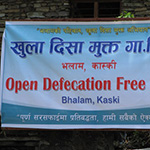
Principles of Sustainability
Chapter 7 - Sustainable Solutions for Water Resources
Part 4 - Sanitation Challenges and Approaches in Developing Countries
 There is a global crisis of inadequate sanitation and water-borne disease, especially in the developing world. According to the World Health Organization about 40% of the world's population, 2.6 billion people, lack safe sanitation. Sustainable sanitary practice and infrastructure is lacking in many areas, and this challenge is coupled with increasing population density and poverty. Open defecation (OD) is common in these areas. Human and animal waste-contaminated surface water and groundwater accessed by wells used for drinking water and irrigation of crops, is a primary vector of contagion.
There is a global crisis of inadequate sanitation and water-borne disease, especially in the developing world. According to the World Health Organization about 40% of the world's population, 2.6 billion people, lack safe sanitation. Sustainable sanitary practice and infrastructure is lacking in many areas, and this challenge is coupled with increasing population density and poverty. Open defecation (OD) is common in these areas. Human and animal waste-contaminated surface water and groundwater accessed by wells used for drinking water and irrigation of crops, is a primary vector of contagion.
Mitigation in the form of community-led total sanitation (CLTS) is an approach that has gained wide acceptance. According to the Handbook on Community-Led Total Sanitation (Kar and Chambers, 2008), CLTS "is an integrated approach to achieving and sustaining open defecation free (ODF) status. CLTS entails the facilitation of the community's analysis of their sanitation profile, their practices of defecation and the consequences, leading to collective action to become ODF." "CLTS processes can precede and lead on to, or occur simultaneously with, improvement of latrine design; the adoption and improvement of hygienic practices; solid waste management; waste water disposal; care; protection and maintenance of drinking water sources; and other environmental measures." CLTS advances the development of latrines and toilets. "A latrine is typically a direct pit, and a toilet is typically an arrangement with a water seal." "OD means open defecation – defecating in the open and leaving the stuff exposed. ODF means open defecation free, that is, when no faeces are openly exposed to the air. A direct pit latrine with no lid is a form of open defecation (fixed point open defecation), but with a fly-proof lid (with or without the use of ash to cover the faeces after defecation) qualifies as ODF. Defecating into a trench and covering the faeces can be part of the transition from OD to ODF."
An analysis of Socio-cultural barriers and triggers to total sanitation in West Africa (WaterAid, 2009), reported that "(i)n 2006, 28 percent of the population of Sub-Saharan Africa (or 221 million people) practised open defecation. In the four focus countries of this study — Burkina Faso, Ghana, Mali, and Nigeria — significant proportions of the population lack access to improved sanitation, and many rural communities practice open defecation." "Environmental sanitation is particularly poor in villages where inadequate or non-existent latrines and a lack of dedicated areas for the disposal of rubbish pollute the local environment. While a lack of sanitation facilities may be attributable to government, poverty, or other factors, community members are responsible for most of the factors that affect their environment and health. Discharging wastewater in public spaces, dumping garbage close to households, and open defecation in areas around the village affects the environment, contaminates groundwater and causes health problems." In West Africa, a major barrier to sanitation in many rural areas exists because "the practice of open defecation is ritualised and bound in tradition."
The mission of the international non-governmental organization WaterAid is to "transform lives by improving access to safe water, hygiene and sanitation in the world's poorest communities." WaterAid cites the following sanitation statistics:
- "7 out of 10 people without sanitation live in rural areas. (WHO/UNICEF)
- Diarrhea kills more children every year than AIDS, malaria and measles combined. (WHO)
- Children living in households with no toilet are twice as likely to get diarrhea as those with a toilet. (WEDC)
- Every year, around 60 million children in the developing world are born into households without access to sanitation. (UN Water)
- One gram of human faeces can contain 10,000,000 viruses, 1,000,000 bacteria, 1,000 parasite cysts, 100 parasite eggs. (UNICEF)
- At any one time half the hospital beds in developing countries are filled with people suffering from diarrhea. (UNDP)"
Keywords
- community-led total sanitation (CLTS)
- open defacation (OD)
- open defecation free (ODF)
- fixed point open defecation
- latrine
- direct pit latrine
- ditch latrine
- flying latrine
- composting toilet
- pour flush toilet
Suggested Reading
- Towards total sanitation Socio-cultural barriers and triggers to total sanitation in West Africa (WaterAid, 2009)
- Handbook on Community-Led Total Sanitation (Kar and Chambers, 2008)
- Economic Impacts of Sanitation Water and Sanitation Program, WSP (2011)
(Photo credit: Mark and Jo Dowle)
